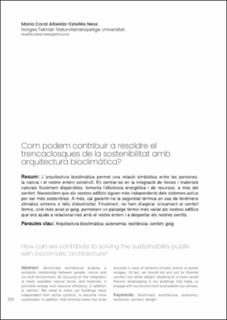| dc.contributor.author | Ness, Maria Coral Albelda-Estellés | |
| dc.date.accessioned | 2024-04-16T11:35:52Z | |
| dc.date.available | 2024-04-16T11:35:52Z | |
| dc.date.created | 2024-03-11T12:16:50Z | |
| dc.date.issued | 2023 | |
| dc.identifier.citation | ANUARI d’Arquitectura i Societat. 2023, (3), 188-204. | en_US |
| dc.identifier.issn | 2792-7598 | |
| dc.identifier.uri | https://hdl.handle.net/11250/3126797 | |
| dc.description.abstract | Bioclimatic architecture enables a symbiotic relationship between people, nature and our built environment. By focusing on the integration of freely available natural forces and materials, it promotes energy and resource efficiency, in addition to comfort. We need to make our buildings more independent from active systems, to become more sustainable. In addition, their thermal safety has to be ensured in case of extreme climatic events or power outages. At last, we should not aim just for thermal comfort, but rather delight, allowing for a more varied thermal landscaping in our buildings that helps us engage with our environment and awaken our senses. | en_US |
| dc.description.abstract | How can we contribute to solving the sustainability puzzle with bioclimatic architecture? | en_US |
| dc.description.abstract | Com podem contribuir a resoldre el trencaclosques de la sostenibilitat amb arquitectura bioclimàtica? | en_US |
| dc.language.iso | eng | en_US |
| dc.publisher | Universitat Politècnica de València | en_US |
| dc.rights | Navngivelse-Ikkekommersiell-DelPåSammeVilkår 4.0 Internasjonal | * |
| dc.rights.uri | http://creativecommons.org/licenses/by-nc-sa/4.0/deed.no | * |
| dc.title | How can we contribute to solving the sustainability puzzle with bioclimatic architecture? | en_US |
| dc.title.alternative | How can we contribute to solving the sustainability puzzle with bioclimatic architecture? | en_US |
| dc.title.alternative | Com podem contribuir a resoldre el trencaclosques de la sostenibilitat amb arquitectura bioclimàtica? | en_US |
| dc.type | Journal article | en_US |
| dc.type | Peer reviewed | en_US |
| dc.description.version | publishedVersion | en_US |
| dc.source.pagenumber | 188-204 | en_US |
| dc.source.journal | ANUARI d’Arquitectura i Societat | en_US |
| dc.source.issue | 3 | en_US |
| dc.identifier.doi | https://doi.org/10.4995/anuari.2023.20146 | |
| dc.identifier.cristin | 2253446 | |
| dc.relation.project | Norges forskningsråd: 257660 | en_US |
| cristin.ispublished | true | |
| cristin.fulltext | original | |
| cristin.qualitycode | 1 | |

